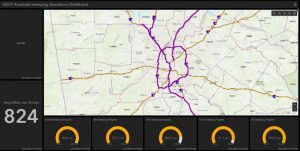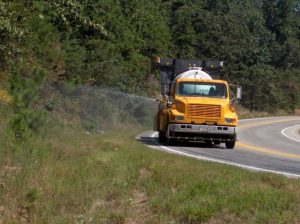Posted by Ray Dorsey
During my 20 years serving as the GDOT state agronomist, I was responsible for the Department’s Integrated Roadside Vegetation Management (IRVM) Program. This included development, strategy, implementation, and review of roadside maintenance operations such as mowing and herbicide applications in controlling undesirable vegetation while improving permanent warm-season grasses.

A key component of any IRVM program is being able to monitor and track roadside maintenance activities as well as the vegetation that is managed. Oversight was at times very frustrating for me due to the lack of tools to properly manage roadsides. When I began my career at GDOT the recordkeeping tool was handwritten forms and charts that the crew leader or foremen recorded. Of course, this was the reality before the computer and software age but was very tedious when sifting through all that paperwork. Things did improve with the development of software programs to monitor maintenance activities. Foreman and crew leaders were able to input their work status and conditions onto their office computers. This made it easier for management staff to see and pull more precise records of work performed.
Though the maintenance management software did fill some of the gaps in monitoring roadside vegetation and work status, I still lacked a solution for tracking existing roadside vegetation, integrating work crews and management, being able to provide a detailed budget for vegetation management and to improve roadside aesthetics. This was further compounded when GDOT implemented privatization in 2012 by contracting roadside maintenance including mowing and herbicide applications. Scheduling and day to day locales of both these operations were hard to track and manage because of multiple contractors performing work across the state.
In 2016, I was introduced to Clearion GIS Workflow Management software via an herbicide application contractor. The contractor had been using Clearion to track their operations internally and provided this technology to GDOT for work tracking and inspection. After implementation, we found that it also was a great tool for planning/scheduling work, tracking the daily status of crew field activities with precise GIS coordinates, mapping existing and problem vegetation, and provided more accurate cost data for budgeting purposes. Both field inspectors and I were impressed by the ease of use of Clearion modules like Mobile and Work Manager and being able to schedule, plan, and inspect the work in the field or at the office. Clearion’s web portal dashboard made it simple to review the herbicide application progress with my managers.
Finally, the right tool was available to manage roadside vegetation!

Since Clearion’s introduction in 2016, GDOT has incorporated GIS workflow management requirements into other roadside maintenance contract specifications including herbicide applications, mowing, wildflower/pollinator planting, and maintenance. In 2019, GDOT required its Atlanta sweeping and drain cleaning maintenance contractors to incorporate GIS workflow management software into their operations as well.
You too can benefit from utilizing Clearion’s technology at your Department of Transportation. Whether monitoring roadside activities or other highway maintenance work, Clearion has the solution. I was so impressed with the power of Clearion’s technology that as I transitioned into a consulting role for Rail and Transportation markets, I jumped at the opportunity to work with Clearion. Please call or email me if you want to talk about your specific project needs or how we can be of service.
